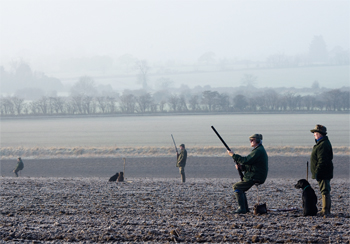10 GOLDEN RULES for setting up a new shoot!

10 GOLDEN RULES for setting up a new shoot.
However, there are a number of factors to consider before embarking. It can be extremely stressful. When things go well no-one thanks you, but when things go wrong everyone wants to let you know.
It will involve countless hours of unpaid work, and best of all will inevitably cost you shed loads of cash! So why are you contemplating this act of sheer lunacy?
If you own land then it may seem an obvious project, but you could rent the ground to someone else and let them take all the flak. If you are thinking about renting ground then talk it through at length with your family, friends and a qualified psychiatrist.
If you are still hell bent on running your own show and can’t be persuaded that burning £50 notes is cheaper and more therapeutic, please consider the following:
1. What type of shoot do you want?
First you need to decide on the type of shoot you wish to run; walked-up, walk and stand, driven and so on.
You also need to consider the number of days and size of the bag you are aiming to achieve. These things should be given serious consideration before all else.
Do not try to run before you can walk; if you haven’t run a shoot before then consider a rough shoot. If you are thinking about running a driven shoot, will it be syndicate, commercial or private?
Will you do everything yourself, employ a gamekeeper, or even employ several? Whichever you decide, do not underestimate the impact on your time and bank balance.
2. What type of ground will you need?
The topography and area will need to be suitable for your desired type of shoot. Deep valleys may be perfect for high driven birds but may not be ideal for a walked-up day with three or four guns.
Thousands of acres may well suit your ego, but there will be a price attached, and this may well send you to somewhere you never intended to go.
How much woodland is there and is it enough or even too much? What state is it in? Huge acreages of well-managed softwood plantation may be totally unattractive to game and wildlife.
Wild and overgrown woods may well be hugely attractive, but perhaps so much so that getting the birds to leave it may prove impossible. And what type of farming is being conducted?
Arable can be very counterproductive. Having hundreds of acres of maize or similar types of crop being grown on the estate can cause a headache for the keeper and is almost impossible to dog-in.
If the land is grazed, will you be able to grow cover crops? Is the land suitable for growing crops? If so, is it in any schemes?
This will need to be understood before ringing the ploughman. With livestock present it will be your responsibility to fence them out – another costly and time-consuming distraction.
3. What does the landlord want?
The relationship with your landlord and/or his agent is crucial to the long-term success of the venture. Make sure you really understand what they require of you and what they don’t want you to do, and not just in the here and now.
Will they support your ambitions, or will you find that there is no room to grow should you want to? It is all too easy to make assumptions and find out later that you have been barking up the wrong tree.
4. Can you afford it?
There is a pretty good understanding of market value out there and people know roughly what to expect to pay for their shooting. You need to work out what you can reasonably charge for your birds.
You then need to consider how much it will cost to achieve. I cannot stress enough the importance of getting your numbers right, because it is too easy to underestimate costs and overlook hidden extras.
It isn’t just the cost of the poults and feed, fuel and vehicles which can mount up.
Getting cover crops to work can involve lots more expenditure than just the seed and contractor. Fertilising, liming, and fencing out live stock can rack up the expenses too. The area most easily overlooked is the miscellaneous expenses; £20 here, £150 there and before you know it thousands of pounds have been spent.
You must look long and hard before concluding what your bottom line looks like. Then, even more importantly, consider your cashflow. Whether you intend to defray costs amongst syndicate guns or sell days to visiting teams, or a mixture of both, you will need a significant amount of cash to tide you over until they cough up.
Being realistic, you won’t get a lot of the money much before the poults are in the pens and by then massive amounts of money will have already been invested. Getting subs in from your friends is a tedious task. It can affect your relationship with them and test your patience to the nth degree.
Let’s face it, many guns don’t start to think about shooting until the season is imminent, and shelling out for next season in the spring seems nonsensical to some.
5. What happens if you have a disaster?
If you’re selling days to visiting guns then you have to deliver the goods. Despite being thoroughly nice chaps, if they have booked a 200-bird day and you struggle to make 50 they will be expecting a refund.
If you’ve only sold a few days to bulk out the syndicate income, you maybe able to bankroll it. But if some catastrophe has left you bereft of birds and you are having to cancel days hand over fist, the consequences could be calamitous.








